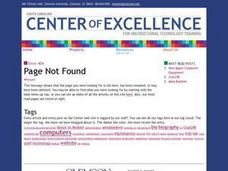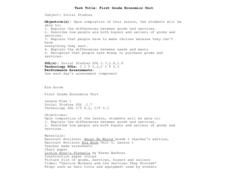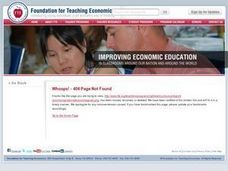Curated OER
Location of Resources in Early Civilizations
Sixth graders define scarcity and opportunity costs.
Federal Reserve Bank
Unintended Consequences
What would your class members say to the opportunity to take two years off of school between grades 10 and 11? Examine the economic concepts of costs, benefits, and unintended consequences with this unique and engaging approach.
Council for Economic Education
Specialization and the Decathlon
Michael Phelps, the economist? Scholars research the economic advantages of specializing in one kind of service, and how it relates to athletes doing the same in their respective sports. They evaluate absolute advantage, production, and...
Practical Money Skills
Making Decisions
A set of quizzes and assessments would make a great companion to your lesson on making decisions and opportunity risks. Learners watch a PowerPoint before answering multiple choice questions about interest rates, saving money, and the...
Practical Money Skills
Making Decisions
Money represents decisions: spending decisions, saving decisions, and investing decisions. Encourage young adults to think about the decisions they make with their money in a three-day unit about personal finance, consumer spending, and...
Federal Reserve Bank
Lesson 1: Katrina Strikes
Most families have an emergency kit in their home with flashlights, water, and extra food. But what happens to your money when disaster strikes? An economics lesson focused on the aftermath of Hurricane Katrina in 2005 demonstrates the...
Council for Economic Education
Great Civilizations Develop around Rivers
If you lived in prehistoric times, what kinds of choices could your family make to increase their chance of survival? By making similar decisions in a simulation game, participants discover how specialization creates both opportunity and...
Curated OER
Economics Worksheet: Opportunity Costs
In this economics worksheet, students use their problem solving skills to calculate opportunity costs and graph their calculations.
Curated OER
First Grade Economics Unit
First graders begin by studying the differences between a "good" and a "service". They compare items to each other to help comprehend the differences. They also look into the differences between buyers and sellers and how the choices...
Curated OER
Prioritizing National Economic Goals
Eighth graders define the generally accepted list of national economic goals. They discuss the compatability/incompatibility of goals. They participate in a consensus-building exercise to rank economic goals in order of importance.
Curated OER
Franchise Opportunity
Pupils identify and evaluate franchise as a business opportunity. Lesson is culminating project in a business course.
Curated OER
The Economy
Students explore the role of government in the economy market. In this economics lesson, students analyze the decision making and how it takes into consideration additional cost, benefits and public awareness of what they are trying to...
Curated OER
Consumer Borrowing and Spending
Credit can be confusing for teens, some of whom are already using credit cards. Clear up misconceptions with this group research activity which has a solid outline with a lot of room to adjust to your needs and resources. Groups are...
Practical Money Skills
Making Money
The first step in managing your money is making money! Learn about ways to find and interview for a job with a thorough lesson plan on personal finances. Kids learn about the ways to earn a paycheck and then manage the funds they receive.
National Park Service
Adeline Hornbek and the Homestead Act: A Colorado Success Story
Learners examine how the Homestead Act impacted the economic opportunities of women. They research the Homestead Act, define Manifest Destiny, and prepare an exhibit featuring an outstanding woman living in their community.
Curated OER
Scarcity, Choice and Decisions
Students study the basic economic trilogy (scarcity, choice, and costs). In this money management lesson, students use a scenario of a High School Prom to calculate how scarcity, choice and cost apply by completing provided worksheets...
Curated OER
Why Nations Trade
Students discuss international trade focusing on opportunity cost and the principle of comparative advantage. They engage in a simulation activity based on different countries and their economic benefits.
Curated OER
The Rising Cost of Health Care: Is there an explanation?
Twelfth graders explore rising health care costs and the Law of Diminishing Marginal Utility. They participate in an activity that demonstrates the Law of Diminishing Marginal Utility. Students read the may 27, 2005 Economic Letter and...
Curated OER
Give and Take
Students analyze a scheduling dilemma. In this opportunity cost and trade-offs lesson, students must schedule the school gym for basketball games, but there are not enough hours for all the games. Groups determine how time will be...
Curated OER
Something from Nothing
Students identify opportunity costs. In this resources instructional activity students are read the story Something from Nothing by Phoebe Gilman. Students list the things Grandpa makes Joseph. Students state why people make choices.
Curated OER
How much money can you earn?
Fifth graders survey how to manage money and the importance of it. Students summarize that each day they have the opportunity to earn or lose money. Students provides many situations to present ways of paying bills and money management.
Curated OER
Uncle Jed's Barbershop
Fourth graders examine productive resources. In this economics lesson, 4th graders read a book about a man who saves money to buy his own barbershop. After reading, students get into groups to play a game to learn about savings.
Curated OER
Where Do You Shop?
Learners examine shopping patterns in another community to develop a hypothesis on why there are more opportunities for goods and services in some neighborhoods while others lack these goods and services.
Council for Economic Education
Timing Is Everything
Students discuss the incentives and opportunity costs of spending vs. saving. They follow an interactive website which shows them the how much money they could end up with by saving instead of spending.

























